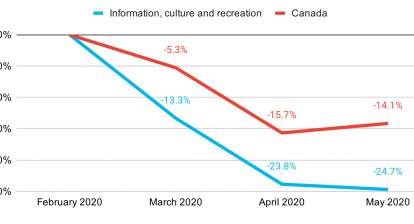In order to provide a detailed picture of job losses in the arts, culture and heritage sector during the COVID-19 crisis, CAPACOA is publishing a first series of custom employment tables.
In past blog posts, we stressed how disaggregated employment statistics paid lip service to the few sectors that are most deeply affected by public health restrictions. Further to discussions with Statistics Canada, we licenced access to employment statistics for arts, culture and heritage sectors and sub-sectors.
These statistics are from the Labour Force Survey, a monthly survey of approximately 56,000 households. They provide an account of employment for full-time, part-time and occasional employees, as well as self-employed workers.
Key findings for June 2020
- Information and cultural industries [51] had 2.5% more jobs in June 2020 than in June 2019. Arts, entertainment and recreation [71] had 31.4% fewer jobs over the same periods. This marked difference confirms the importance of accessing and analyzing disaggregated data series.
- Sub-sectors dependent on admission revenues lost proportionally considerably more jobs than other industries. These include “performing arts companies” [7111], “spectator sports” [7112], and “promoters (presenters) of performing arts, sports and similar events” [7113].
- Performing arts companies [7111] and promoters (presenters) of performing arts, sports and similar events [7113] were both at roughly 50% of their pre-COVID level in June. These two sub-sectors had lost 22,000 jobs in June 2020 compared to June 2019. They also kept shedding jobs in June compared to May (whereas most other sub-sectors were starting to see a rebound).
- The sub-sectors that lost the most jobs also saw the sharpest decline in actual hours worked. This means those lucky enough to still be considered “employed” worked fewer hours than before the COVID.
- Actual hours worked were down 52.2% in performing arts, spectator sports and related industries [711] in June 2020, compared to June 2019. A comparable decrease (-45.8%) was observed in amusement, gambling and recreation [713].
- Performing arts companies saw the largest decrease in total hours worked: -73,5%. (they are technically second to amusement parks and arcades, but the data series for this industry is unreliable).
- Independent artists, writers and performers [7115], a sub-sector that includes a very large proportion of self-employed workers, worked 35.9% fewer hours in June 2020 compared to June 2019.
Table 1 – Employment estimates (x 1,000), by selected industries, Canada, unadjusted for seasonality
| Industry (with NAICS classification) | Employment, June 2020 (x1,000) | June 2020 c. June 2019 (%) | June 2020 c. June 2019 (x1,000) |
|---|---|---|---|
| Total, all industries | 17777.8 | -8.3% | -1615.1 |
| 51, 71 Information, culture and recreation 1 | 678.2 | -17.5% | -143.9 |
| 51 Information and cultural industries | 344.5 | 2.5% | 8.5 |
| 71 Arts, entertainment and recreation | 333.7 | -31.4% | -152.4 |
| 711 Performing arts, spectator sports and related industries | 114.4 | -23.4% | -34.9 |
| 7111 Performing arts companies | 19.3 | -44.1% | -15.2 |
| 7112 Spectator sports | 9.1 | -60.3% | -13.8 |
| 7113 Promoters (presenters) of performing arts, sports and similar events 2 | 5.5 | -56.7% | -7.2 |
| 7114 Agents and managers for artists, athletes, entertainers and other public figures 3 | x | x | x |
| 7115 Independent artists, writers and performers | 74.3 | -1.1% | -0.8 |
| 712 Heritage institutions | 33.9 | -21.5% | -9.3 |
| 713 Amusement, gambling and recreation industries | 185.5 | -36.8% | -108 |
Notes
- This series aggregates two distinct industry classifications. Statistics Canada aggregates culture industries in such a way in order to ensure data quality at small geographic levels. This aggregated series is included in order to enable some degree of comparison with data tables published by Statistics Canada.
- The sample for this series is small, and data accuracy is usually acceptable. However, for June 2020, the coefficient of variation fell below the reliability threshold. These data points should be used with caution.
- The sample for this series is too small and there is significant month-to-month variation. It is not accurate enough for release.
Table 2 – Total actual hours worked estimates (x 1,000), by selected industries, Canada, unadjusted for seasonality
| Industry (with NAICS classification) | Total actual hours worked June 2020 (x1,000) | June 2020 c. June 2019 (% change) |
|---|---|---|
| Total, all industries | 561271.8 | -14.6% |
| 51, 71 Information, culture and recreation 1 | 18718.7 | -26.3% |
| 51 Information and cultural industries | 11259.3 | -5.0% |
| 71 Arts, entertainment and recreation | 7459.4 | -45.0% |
| 711 Performing arts, spectator sports and related industries | 2079.6 | -52.2% |
| 7111 Performing arts companies 2 | 298.8 | -73.5% |
| 7112 Spectator sports 2 | 296.1 | -61.3% |
| 7113 Promoters (presenters) of performing arts, sports and similar events 3 | x | x |
| 7114 Agents and managers for artists, athletes, entertainers and other public figures 3 | x | x |
| 7115 Independent artists, writers and performers | 1234.4 | -35.9% |
| 712 Heritage institutions | 1128.2 | -17.6% |
| 713 Amusement, gambling and recreation industries | 4251.5 | -45.8% |
Notes
- This series aggregates two distinct industry classifications. Statistics Canada aggregates culture industries in such a way in order to ensure data quality at small geographic levels. This aggregated series is included in order to enable some degree of comparison with data tables published by Statistics Canada.
- The sample for this series is small, but data accuracy is acceptable.
- Data is unreliable and unsuited for release.
Additional notes to readers
- “Employment” includes full-time, part-time and occasional employees, as well as self-employed workers who worked during the reference week, no matter how many hours. Certain sub-sectors that include a large proportion of self-employed workers, for example independent artists, may therefore not show a significant drop because those freelance workers may still have been considered “working”.
- “Total actual hours worked” is a good indicator of the impacts of COVID-related restrictions on the labour force, because it offers an account of both the number of employed workers and the hours they worked. It is a particularly relevant indicator for sub-sectors that include a lot of freelance and occasional workers (and who may be deemed as “employed” even if they only worked a few hours during the reference period). For example, employment among independent artists dropped only -1.1% between June 2020 and June 2019. However, actual hours worked dropped 35.9% over the same period.
- These statistics are not adjusted for seasonality (whereas many Statistics Canada tables are). Many culture industries are subject to significant seasonal variations. In order to have a fair estimation of employment change compared to pre-COVID level, it is therefore preferable to establish comparisons with the same period in 2019 rather than with February 2020.
Prepared by: Frédéric Julien, Director of Research and Development









Pingback: Three weeks to go! – Live Event Community
Pingback: Light Up Live Sept 22nd Press Release - Galactic Entertainment